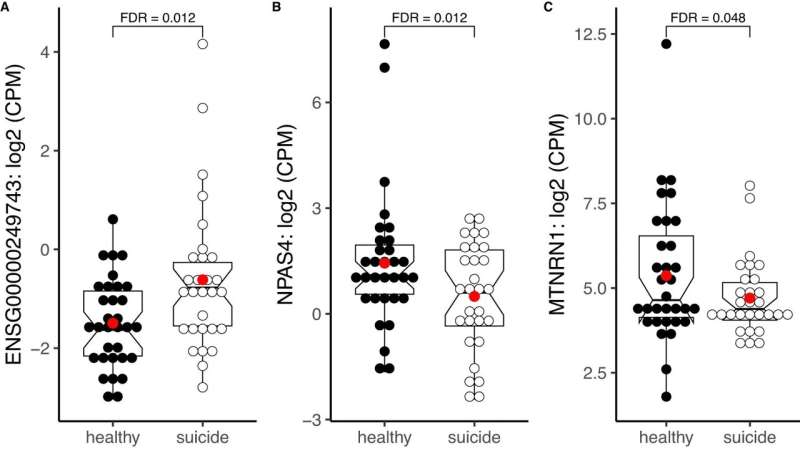This article has been reviewed according to Science X's editorial process and policies. Editors have highlighted the following attributes while ensuring the content's credibility:
fact-checked
peer-reviewed publication
trusted source
proofread
Inflammation and loss of protective mechanisms in the brain linked to suicide risk

A first-of-its-kind study has identified overactive inflammation and loss of critical protection mechanisms in the brain as potential contributors to suicide risk.
The findings support further exploration of anti-inflammatory medications to reduce risk, especially in situations where suicidal ideation can be ascertained early.
The study was published in the journal Molecular Psychiatry and led by Van Andel Institute's Lena Brundin, M.D., Ph.D., Columbia University Department of Psychiatry's J. John Mann, M.D., and Western Michigan University Homer Stryker M.D. School of Medicine's Eric Achtyes, M.D., M.S.
"As suicide rates continue to rise, we must develop additional evidence-based strategies to address all the factors that contribute to suicide risk," Brundin said. "Our study pinpoints several key changes in the brain that one day could be targeted for treatment with the goal of reducing risk and saving lives."
Suicidal behavior is driven by a mix of psychological, social and biological factors. Earlier research—including previous findings by Brundin, Mann and Achtyes—suggests sustained inflammation may cause a toxic imbalance that alters brain chemistry and elevates suicide risk.
The new findings build on this earlier work by identifying key molecular differences that drive inflammation and may contribute to suicidal behavior.
The research team compared the brains of 29 people who died by suicide to brains of 32 people who died from other causes. The people who died by suicide in the study were largely free of antidepressive and antipsychotic medications, which enabled the team to more clearly see suicide-associated molecular changes that otherwise may be masked.
"Our goal is to prevent suicide by better understanding the brain function associated with it," Mann said. "We focused on the brain because that's where the biological processes that affect mood, suicidal ideation and intent, and decision-making reside. This study enabled us to see the brain at the moment of greatest risk and pinpoint biological markers of that risk."
Overall, the team found increased inflammation paired with reduced activity in mechanisms that protect the brain. Specific changes in the brains of people who died by suicide include:
- Less activity in the gene NPAS4, which regulates inflammation and helps maintain brain cell health. This reduced activity enables inflammation.
- More excitotoxicity, an inflammatory process contributing to cell death.
- Fewer oligodendrocytes—specialized cells that protect nerve fibers. Evidence suggests these vital cells may succumb to damage caused by inflammation, leaving nerve fibers vulnerable.
The study also represents the most thorough analysis to date of integrated gene methylation and transcriptomic data derived from the brains of people who died by suicide. Gene methylation is a process that switches genes "on" or "off" by annotating them with special chemical tags. In people who died by suicide, the study found methylation patterns that promoted aberrant inflammation.
In tandem with the current study, Brundin, Mann, and Achtyes are searching for biomarkers—measurable substances—in the blood that correspond to suicide risk. They envision a future in which clinicians have a validated blood test to evaluate suicide risk and approved treatment strategies to reduce that risk, potentially by targeting inflammation. Toward this goal, future studies will focus on further understanding inflammation's role in suicide risk, searching for biomarkers, and devising strategies to evaluate potential treatment options.
"Clinicians desperately need enhanced ways to identify patients at increased risk of suicide," Achtyes said. "Detecting patterns in molecular markers to flag those at heightened risk could be a valuable tool for helping individuals who are struggling."
More information: Qiong Sha et al, Integrative transcriptome- and DNA methylation analysis of brain tissue from the temporal pole in suicide decedents and their controls, Molecular Psychiatry (2023). DOI: 10.1038/s41380-023-02311-9



















